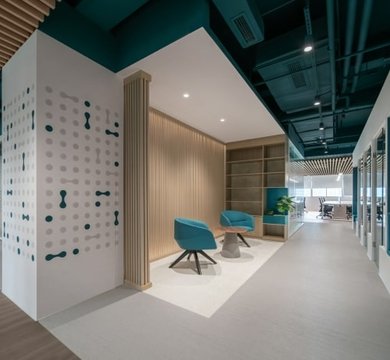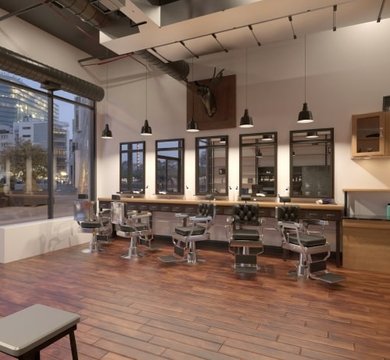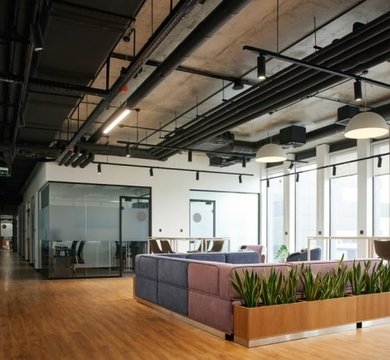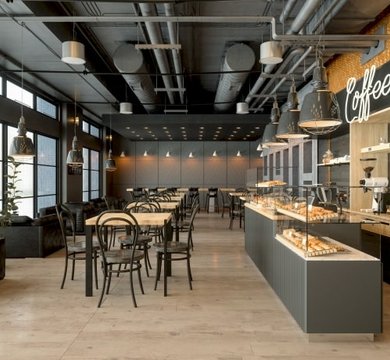The carbon footprint and drain on resources when working on a commercial refurb or creating interior design for offices should not be ignored. When the industry works together, it can drastically reduce the negative impact on the environment, and BREEAM standards are here to inform and encourage sustainable choices from a project’s inception.
A good BREEAM rating and subsequent certificate can make a premise more marketable by appealing to eco conscious tenants and potentially achieving a higher rental value. BREEAM compliance will also help companies achieve a good commercial EPC rating, B Corp Certification or a Cat C fitout that’s part of the emerging circular economy.
What is BREEAM?
So, what is BREEAM? BREEAM stands for Building Research Establishment Environmental Assessment Methodology. BREEAM was developed by BRE (the Building Research Establishment) in 1990, quickly becoming a globally-recognised benchmark for sustainability in construction, commercial refurbishment and retail fitout.
BREEAM Refurbishment & Fitout provides a framework that building owners/managers can follow in order to deliver high-performing, sustainable workplaces during construction, refurbishment and fitout. Assets that are assessed include the external envelope, structure, core services, local services and interior design of a project.
After completion, BREEAM In-use allows building owners/managers to assess how sustainable their functional premise is on an ongoing basis.
BREEAM Ratings
When a premise is assessed, the outcome isn’t as simple as pass or fail. The BREEAM rating system allows those engaging with a company to see, at a glance, how well a company has performed within the BREEAM standards framework.
Understanding the Ratings
The BREEAM rating system works on a sliding scale, with six possible classifications according to what percentage of the assessment criteria has been met or exceeded. These are:
- Outstanding: for projects that achieve 85% or more of the available assessment score. A BREEAM rating of outstanding recognises exemplary best practice and the highest level of sustainability performance.
- Excellent: for projects that achieve 70% or more of the available assessment score.
- Very Good: for projects that achieve 55% or more of the available assessment score.
- Good: for projects that achieve 45% or more of the available assessment score.
- Pass: for projects that achieve 30% or more of the available assessment score.
- Unclassified: for projects that have not met the minimum standard to achieve a pass BREEAM rating.
The Impact of Ratings
BREEAM estimates that a certified building is 8-12% more valuable than a standard building. The most valuable buildings will be those with the best BREEAM rating. The rating can also be a deal clincher when it comes to renting or selling a premise – two similar, certified buildings may only be separable by their BREEAM rating.
The highest BREEAM rating will also deliver the biggest cost savings through reduced consumption of energy to heat, light and power a building. Future savings should offset any investment made to achieve a high rating, and a sustainable working environment will also improve the health and wellbeing of occupants.
BREEAM Categories
When it comes to assessing a building or project, BREEAM takes a holistic approach, examining a variety of aspects. These are known as BREEAM categories and they span:
Energy Efficiency
Assessing how efficient a building is by measuring how much energy it uses. The assessment will look for the installation of energy-efficient systems and renewable energy sources. Meaningful energy management will reduce operational costs and will decrease a building’s carbon output.
Health & Wellbeing
The health, comfort and wellbeing of occupants is at the heart of this BREEAM category. Factors, such as air quality, lighting, thermal comfort and acoustic performance, are taken into account. When occupants are looked after, they tend to perform more productively and with a greater sense of job satisfaction.
Materials & Waste
Of all the BREEAM categories, this one is particularly pertinent for those engaged in shell & core and Cat A refurbishments. Materials will be assessed to see why they were chosen, where they came from, how they were installed and what their lifespan is. The amount of waste produced at all stages of a project will also be examined. The assessment will expect to see evidence of reuse, recycling and a reduction of waste going to landfill.
Water Management
BREEAM standards demand an eco approach to water, both during construction and fitout stages, and during occupation. Aspects such as the use of low-flow fixtures, water recycling systems and efficient irrigation will be rewarded. In return, building owners and occupants will enjoy lower water bills and reassurance that they are helping conserve a precious natural resource.
Land Use Ecology & Pollution
A project will be assessed on how it has protected and enhanced the site’s ecology and biodiversity via sustainable land use and landscaping practices. As well as the impact on the natural environment, the assessment will look favourably on projects where noise, light, air, and water pollution have been avoided or minimised.
Management & Innovation
The best BREEAM ratings are reserved for projects where the impact on the environment and health & safety was well managed during the construction and fitout stages, and where ongoing sustainability is a high priority. Credit is also given where innovative practices, boundary-pushing technology and pioneering solutions not covered in other categories are evidenced.
Transport
As well as a building’s location, in regards to its proximity to transport hubs and local services, being taken into account, BREEAM standards expect projects to encourage reduced car use and promote alternative modes of transport, like cycling and walking.
Benefits of BREEAM Certification
A BREEAM In-Use certificate is valid for three years after the certification date, so that’s 36 months to press home and enjoy the advantages, which include:
Financial and Environmental Impact
Achieving BREEAM certification is a guaranteed way of being kinder to the environment. Defaults of a high BREEAM rating will be a reduction in carbon emissions, less waste going to landfill, less reliance on energy sources, a healthier working environment and a concerted contribution towards net zero.
The financial rewards aren’t to be overlooked. Operational costs will fall as a result of BREEAM certification. It’s as simple as ‘the less water, gas and electricity used, the lower the fuel bills’. As mentioned earlier, a BREEAM certified building can also command more on the commercial sales and lettings markets.
Corporate Social Responsibility (CSR) and Marketability
Being certified with a high BREEAM rating is a reputation-enhancing sign that a company is invested in sustainability and takes its environmental responsibility seriously. It carries serious marketing clout and can help set companies apart. A high BREEAM rating is becoming increasingly important in business-to-business and business-to-consumer relationships, as people seek to only work with companies who have aligned eco principles.
MPL BREEAM Case Studies
Our refurb and fitout projects for Yoooserve were executed within the BREEAM framework. Both No.5, The Heights, Weybridge and The Abbey in Reading – designed, specified and fitted by MPL – have both achieved BREEAM certification, each with a ‘very good’ rating.













